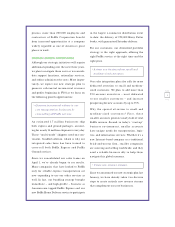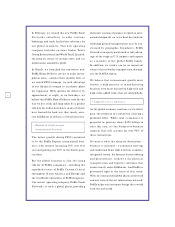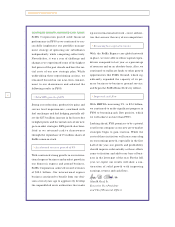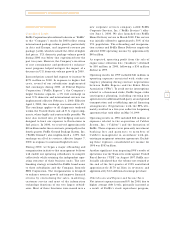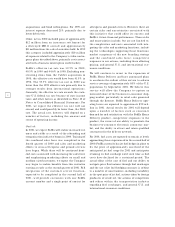Federal Express 2000 Annual Report Download - page 15
Download and view the complete annual report
Please find page 15 of the 2000 Federal Express annual report below. You can navigate through the pages in the report by either clicking on the pages listed below, or by using the keyword search tool below to find specific information within the annual report.
FedEx
Corp.
13
$478 million of the credit facility remains avail-
able. For more inform ation regarding the credit
facility, see N ote 5 of Notes to Consolidated
Financial Statem ents.
During 2000, FedEx acquired three businesses for
approxim ately $264 million, prim arily in cash.
These purchases were funded from operations and
borrowings under our comm ercial paper program.
On Septem ber 27, 1999, the Company’s Board of
Directors approved a plan that authorized the pur-
chase of up to 15 million, or approxim ately 5% , of
FedEx’s outstanding shares of com m on stock. We
com pleted the purchase of 15 m illion shares at an
average cost of $39.75 per share. The purchase of
these shares was funded principally through the
issuance of com m ercial paper. Shares held in trea-
sury will be used for general corporate purposes.
FedEx Express redeem ed $100 m illion of 9.625%
unsecured sinking fund debentures on March 1,
2000. The bond redem ption was financed with
com m ercial paper borrowings.
In 1999, FedEx filed a $1 billion shelf registration
statem ent with the Securities and Exchange
Com m ission (“SEC”), indicating that we may issue
up to that amount in one or m ore offerings of either
unsecured debt securities, preferred stock or com -
m on stock, or a com bination of such instrum ents.
The Com pany m ay, at its option, direct FedEx
Express to issue guarantees of the debt securities.
We believe that cash flow from operations, our
com m ercial paper program and revolving bank
credit facility will adequately meet the Com pany’s
working capital needs for the foreseeable future.
Capital Resources
FedEx’s operations are capital intensive, character-
ized by significant investments in aircraft, vehicles,
com puter and telecomm unications equipm ent,
package handling facilities and sort equipm ent. The
am ount and timing of capital additions depend on
various factors including volum e growth, dom estic
and international econom ic conditions, new or
enhanced services, geographical expansion of serv-
ices, com petition, availability of satisfactory financ-
ing and actions of regulatory authorities.
The following table com pares capital expenditures
(including equivalent capital, which is defined
below) for the years ended May 31 (in millions):
2000 1999
Aircraft and related equipment $ 469 $ 606
Facilities and sort equipment 437 466
Information and
technology equipm ent 378 366
Other equipment 343 332
Total capital expenditures 1,627 1,770
Equivalent capital, principally
aircraft-related 365 561
Total $1,992 $2,331
FedEx finances a significant amount of its aircraft
and certain other equipm ent needs using long-
term operating leases. We believe the determ ina-
tion to lease versus buy equipm ent is a financing
decision, and both form s of financing are consid-
ered when evaluating the resources com m itted for
capital. The amount that the Com pany would have
expended to purchase these assets had it not cho-
sen to obtain their use through operating leases is
considered equivalent capital in the table above.
While capital expenditures over the past two years
have been reduced based on lower than expected
U.S. domestic volume growth at FedEx Express, we
plan to continue to m ake strategic capital invest-
m ents in support of our long-term growth goals.
For 2001, we expect capital spending, including
equivalent capital, to approximate $2.3 billion.
For inform ation on the Company’s purchase com-
m itm ents, see Note 14 of N otes to Consolidated
Financial Statem ents.
We have historically financed our capital invest-
m ents through the use of lease, debt and equity
financing in addition to the use of internally gener-
ated cash from operations. Generally, our practice
in recent years with respect to funding new wide-
bodied aircraft acquisitions has been to finance
such aircraft through long-term lease transactions
that qualify as off-balance sheet operating leases
under applicable accounting rules. We have deter-
m ined that these operating leases have provided
econom ic benefits favorable to ownership with
respect to market values, liquidity and after-tax
cash flows. In the future, other forms of secured
financing m ay be pursued to finance FedEx Express’s


